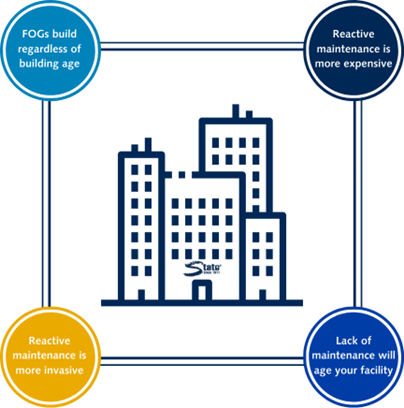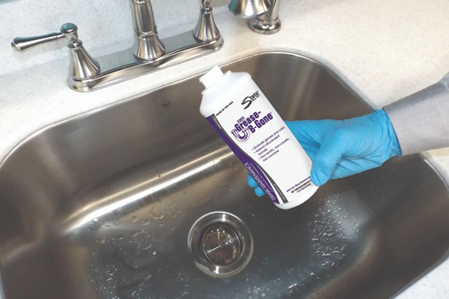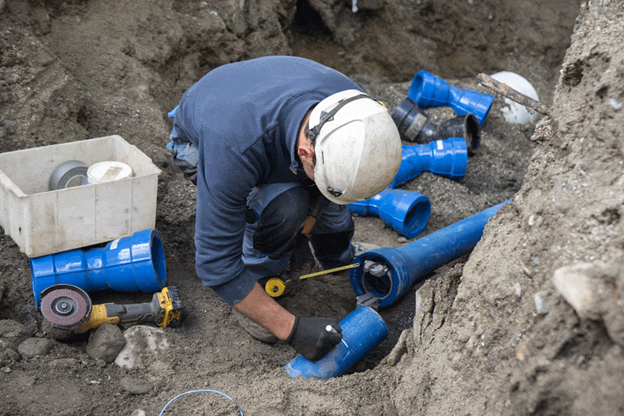Does a New Building Need Drain Care?
Does a New Building Need Drain Care?
You have a brand-new building with new fixtures, new plumbing—the works. So, why would you need to bother with drain care? It’s not like your facility is experiencing any wear and tear; it just opened.
State Chemical has been manufacturing and distributing chemical solutions since 1911, and we have heard mindsets like this for as long as we’ve been around. We know that when your building is shiny and new, you don’t see any issues. In this situation, it’s easy to feel that drain care is unnecessary.
However, new buildings need drain care to maintain this newness and lack of plumbing problems. In this article, we will explain the benefits of drain maintenance in new buildings. After reading, you’ll understand why drain care is important for new facilities.
Drain Buildup Happens Regardless of Your Building’s Age
Without any visible issues, it’s easy to write off drain maintenance. Out of sight, out of mind, after all. However, the main reason for drain problems is buildup—and buildup happens regardless of your building’s age.
When anything goes down your drain, fats, oils, and greases (FOGs) go down your drain with it. Even when you wash your hands, body oil is washed down the sink. And this collection of FOGs will harden and cling to the insides of your pipes.
Think about the human body—namely the arteries. As a child, you have a clean slate. The blood runs smoothly; there are no blockages or clogs.
However, if you eat a lot of greasy, fatty, salty foods, your arteries will start to clog from the walls inward as you age—just like a pipe.
You might not see the impact of FOGs on your new pipes instantly; it could take months or even years. But like taking care of a child, if you don’t give your drains a “healthy diet,” so to speak, buildup will start somewhere. Once it starts, it only continues to build.
And once it builds, this buildup will form clogs and backups as well as attracting odors and drain flies. Without chemical intervention, even if you knock it out with a drain snake, these issues will just keep occurring again and again, creating a headache for your staff and an unpleasant experience for your customers.
Your Facility Will Wear Down Faster Without Drain Care
Additionally, your facility’s pipes will wear down faster if you don’t maintain them.
As previously stated, FOG buildup will happen regardless of your building’s age. And when it happens, it wears down your facility more quickly.
When you have a five-year-old building dealing with constant drain backups and clogs, it has aged itself. It no longer has the value of a new building when the drains have the odors and functionality of a twenty-year-old building.
This can then affect your facility’s operations, its property value, and your brand as a whole. Customers are more likely to be turned off by seemingly unclean facilities, unclean facilities make it harder to run, and buyers won’t be as interested in purchasing a property experiencing advanced aging.
Meanwhile, with regular maintenance, the facility will be clean for customers, operations won’t be affected, and property values won’t dip. All in all, these issues won’t be a concern for you.
Prevent Plumbing Problems with Regular Drain Maintenance
In practice, preventing drain problems means completing regular maintenance. Drain maintainers are chemicals you can regularly apply to your drains to clear FOGs before they build up. This prevents problems before you start to see them.
Plus, there are drain maintainers available for different needs. You can choose between emulsifiers and biologicals (or get a product containing both). You can pick manual or automated maintenance. You can apply as frequently or infrequently as needed.
Drain maintenance is highly customizable, making it easy to integrate into your individual facility, and it’s a safety net between you and frustrating drain problems.
Reactive Drain Maintenance is More Costly and Damaging
But what happens if you wait until you notice an issue?
If you elect to wait until your new building starts exhibiting problems, preventative drain maintenance likely won’t be a possibility anymore. Some drain maintainers, such as our product Grease-B-Gone, are strong enough to handle minor clogs, but generally speaking, if your problem gets to the point of clogs and backups, you’ll need a drain opener or plumber—reactive maintenance.
Reactive maintenance tends to cost significantly more than preventative maintenance. Additionally, it tends to be more invasive and damaging to your facility. Just think about how much rearranging it would take to schedule a plumber, who then drills into your floor to repair a section of piping. Pouring chemicals down your drain takes far less effort.
The upfront cost and hassle of preventative drain maintenance probably weighs on you, but if you want the most efficient method to prevent drain issues in the first place, preventative maintenance is the way to go.
Invest in Preventative Drain Maintenance for New Buildings
With a new building, you don’t see any plumbing issues, which makes it difficult to justify an investment in preventative maintenance. Now that you know how new buildings can be affected by drain problems, consider the cost of preventative maintenance compared to reactive maintenance.












